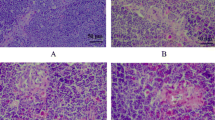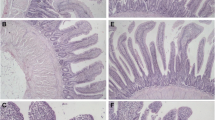Abstract
Selenium (Se) is an important nutritional trace element possessing immune-stimulatory properties. The aim of this 75-day study was to investigate effect of oxidative stress on immunosuppression induced by selenium deficiency by determining antioxidative function, morphological changes, DNA damage, and immune function in immune organ of chickens. One hundred sixty 1-day-old chickens (egg-type birds) were randomly assigned to two groups of 80 each and were fed on a low-Se diet (0.032 mg/kg Se) or a control diet (0.282 mg/kg Se, sodium selenite), respectively. Se contents in blood and immune organ (thymus, spleen, bursa of Fabricius) were determined on days 30, 45, 60, and 75, respectively. Antioxidative function was examined by total antioxidant capacity (T-AOC), superoxide dismutase (SOD), glutathione peroxidase (GSH-Px), and xanthine oxidase (XOD), and oxidative damage was examined by malondialdehyde (MDA) detection. DNA damage was measured by comet assay, and immune function was examined by determining serum interleukin-1β (IL-1β), interleukin-2 (IL-2), and tumor necrosis factor (TNF) contents. The results showed that Se concentrations in the low-Se group were significantly lower (P < 0.05) than in the control group. Low-Se diet caused a decrease in the activities of T-AOC, SOD, GSH-Px, and an increase in XOD activity and MDA content. Pathological lesions and DNA damage of immune tissues were observed in low-Se group, while the serum IL-1β and IL-2 contents decreased, and TNF content increased. The present study demonstrated that chickens fed deficient in Se diets exhibited lesions in immune organs, decreased serum IL-1β, IL-2 content, and serum TNF content, indicating that oxidative stress inhibited the development of immune organs and finally impaired the immune function of chickens.









Similar content being viewed by others
References
Carlson BA, Yoo MH, Shrimali RK et al (2010) Role of selenium-containing proteins in T-cell and macrophage function. Proc Nutr Soc 69:300–310
Li JL, Li HX, Li S et al (2011) Selenoprotein W gene expression in the gastrointestinal tract of chicken is affected by dietary selenium. Biometals 24:291–299
Diplock AT (1987) Dietary supplementation with antioxidants. Is there a case for exceeding the recommended dietary allowance. Free Radic Biol Med 3:199–201
Rayman MP (2000) The importance of selenium to human health. Lancet 356:233–241
Jayaprakash V, Marshall JR (2011) Selenium and other antioxidants for chemoprevention of gastrointestinal cancers. Best Pract Res Clin Gastroenterol 25:507–518
Kaushal N, Bansal MP (2007) Dietary selenium variation-induced oxidative stress modulates CDC2/cyclin B1 expression and apoptosis of germ cells in mice testis. J Nutr Biochem 18:553–564
Hadley KB, Sunde RA (2001) Selenium regulation of thioredoxin reductase activity and mRNA levels in rat liver. J Nutr Biochem 12:693–702
Singh K, Ahluwalia P (2012) Effect of monosodium glutamate on lipid peroxidation and certain antioxidantenzymes in cardiac tissue of alcoholic adult male mice. J Cardiovasc Dis Res 3:12–18
Bhaskaram P (2002) Micronutrient malnutrition, infection, and immunity: an overview. Nutr Rev 60:S40–S45
Brown KM, Arthur JR (2001) Selenium, selenoproteins and human health: a review. Public Health Nutr 4:593–599
Gromer S, Eubel JK, Lee BL et al (2005) Human selenoproteins at a glance. Cell Mol Life Sci 62:2414–2437
McKenzie RC, Rafferty TS, Beckett GJ (1998) Selenium: an essential element for immune function. Immunol Today 19:342–345
Kiremidjian-Schumacher L, Roy M (1998) Selenium and immune function. Z Ernährungswiss 37(Suppl 1):50–56
Chan S, Gerson B, Subramaniam S (1998) The role of copper, molybdenum, selenium, and zinc in nutrition and health. Clin Lab Med 18:673–685
Winnefeld K (1997) Selenium, antioxidant status and radical/reactive oxygen species in medicine. Med Klin (Munich) 92(Suppl 3):8–10
Pighetti GM, Eskew ML, Reddy CC et al (1998) Selenium and vitamin E deficiency impair transferrin receptor internalization but not IL-2, IL-2 receptor, or transferrin receptor expression. J Leukoc Biol 63:131–137
Hasunuma R, Ogawa T, Kawanishi Y (1982) Fluorometric determination of selenium in nanogram amounts in biological materials using 2,3-diaminonaphthalene. Anal Biochem 126:242–245
Opara EC, Abdel-Rahman E, Soliman S et al (1999) Depletion of total antioxidant capacity in type 2 diabetes. Metabolism 48:1414–1417
Rotruck JT, Pope AL, Ganther HE et al (1973) Selenium: biochemical role as a component of glutathione peroxidase. Science 179:588–590
Zhang ZW, Lv ZH, Li JL et al (2011) Effects of cold stress on nitric oxide in duodenum of chicks. Poult Sci 90:1555–1561
Montufar-Solis D, Klein JR (2006) An improved method for isolating intraepithelial lymphocytes (IELs) from the murine small intestine with consistently high purity. J Immunol Methods 308:251–254
Singh NP, McCoy MT, Tice RR et al (1988) A simple technique for quantitation of low levels of DNA damage in individual cells. Exp Cell Res 175:184–191
Zhang XY, Zhou DF, Cao LY et al (2002) Decreased production of interleukin-2 (IL-2), IL-2 secreting cells and CD4+ cells in medication-free patients with schizophrenia. J Psychiatr Res 36:331–336
Hsieh HS, Ganther HE (1975) Acid-volatile selenium formation catalyzed by glutathione reductase. Biochemistry 14:1632–1636
Bjornstedt M, Kumar S, Holmgren A (1992) Selenodiglutathione is a highly efficient oxidant of reduced thioredoxin and a substrate for mammalian thioredoxin reductase. J Biol Chem 267:8030–8034
Veres Z, Kim IY, Scholz TD et al (1994) Selenophosphate synthetase. Enzyme properties and catalytic reaction. J Biol Chem 269:10597–10603
Ferreccio C, Gonzalez PC, Milosavjlevic SV et al (1998) Lung cancer and arsenic exposure in drinking water: a case–control study in northern Chile. Cad Saude Publica 14(Suppl 3):193–198
Papp LV, Lu J, Holmgren A et al (2007) From selenium to selenoproteins: synthesis, identity, and their role in human health. Antioxid Redox Signal 9:775–806
Sunde RA, Hadley KB (2010) Phospholipid hydroperoxide glutathione peroxidase (Gpx4) is highly regulated inmale turkey poults and can be used to determine dietary selenium requirements. Exp Biol Med (Maywood) 235:23–31
Bozkaya LA, Ozturk-Urek R, Aydemir T et al (2001) Effects of Se, Cu and Se + vitamin E deficiency on the activities of CuZnSOD, GSH-Px, CAT and LPO levels in chicken erythrocytes. Cell Biochem Funct 19:153–157
Jun EJ, Ye JS, Hwang IS et al (2011) Selenium deficiency contributes to the chronic myocarditis in coxsackievirus-infected mice. Acta Virol 55:23–29
Zuberbuehler CA, Messikommer RE, Arnold MM et al (2006) Effects of selenium depletion and selenium repletion by choice feeding on selenium status of young and old laying hens. Physiol Behav 87:430–440
Xu JX, Wang J, Wang T (2007) Effects of vitamin E and selenium on the metabolism of free radicals in broilers. Ying Yong Sheng Tai Xue Bao 18:1789–1793
Thomson CD, Chisholm A, McLachlan SK et al (2008) Brazil nuts: an effective way to improve selenium status. Am J Clin Nutr 87:379–384
Rayman MP (2000) The importance of selenium to human health. Lancet 356:233–241
Cooke MS, Olinski R, Evans MD (2006) Does measurement of oxidative damage to DNA have clinical significance. Clin Chim Acta 365:30–49
Avanzo JL, de Mendonca CX, Jr PSM et al (2001) Effect of vitamin E and selenium on resistance to oxidative stress in chicken superficial pectoralis muscle. Comp Biochem Physiol C Toxicol Pharmacol 129:163–173
Collins AR (2004) The comet assay for DNA damage and repair: principles, applications, and limitations. Mol Biotechnol 26:249–261
Peng X, Cui Y, Cui W et al (2011) The cell cycle arrest and apoptosis of bursa of Fabricius induced by low selenium in chickens. Biol Trace Elem Res 139:32–40
Harbige LS (1996) Nutrition and immunity with emphasis on infection and autoimmune disease. Nutr Health 10:285–312
Kiremidjian-Schumacher L, Roy M, Wishe HI et al (1994) Supplementation with selenium and human immune cell functions II. Effect on cytotoxic lymphocytes and natural killer cells. Biol Trace Elem Res 41:115–127
Sobolev SM, Nikolaeva TN, Pronin AV (2011) “Non-immune” interactions of gamma-globulin in regulation of immune reactions. Vestn Ross Akad Med Nauk 10:60–62
Brigelius-Flohe R, Banning A, Kny M et al (2004) Redox events in interleukin-1 signaling. Arch Biochem Biophys 423:66–73
Bonham M, O'Connor JM, Hannigan BM et al (2002) The immune system as a physiological indicator of marginal copper status. Br J Nutr 87:393–403
Sethi G, Sung B, Aggarwal BB (2008) TNF: a master switch for inflammation to cancer. Front Biosci 13:5094–5107
Johnson VJ, Tsunoda M, Sharma RP (2000) Increased production of proinflammatory cytokines by murine macrophages following oral exposure to sodium selenite but not to seleno-l-methionine. Arch Environ Contam Toxicol 39:243–250
Maddox JF, Aherne KM, Reddy CC et al (1999) Increased neutrophil adherence and adhesion molecule mRNA expression in endothelial cells during selenium deficiency. J Leukoc Biol 65:658–664
Peng X, Cui H, Yuan J et al (2011) Low-selenium diet induces cell cycle arrest of thymocytes and alters serum IL-2 content in chickens. Biol Trace Elem Res 144:688–694
Acknowledgments
This study was supported by the National Natural Science Foundation of China (30871902) and the Science Foundation of the Education Department of Heilongjiang Province (11551030). The authors thank the members of the veterinary internal medicine laboratory, especially the members of the cold stress group, in College of Veterinary Medicine, Northeast Agricultural University for help in feeding the chicks and analyzing the data.
Author information
Authors and Affiliations
Corresponding authors
Additional information
All authors have read the manuscript and have agreed to submit it in its current form for consideration for publication.
Rights and permissions
About this article
Cite this article
Zhang, Zw., Wang, Qh., Zhang, Jl. et al. Effects of Oxidative Stress on Immunosuppression Induced by Selenium Deficiency in Chickens. Biol Trace Elem Res 149, 352–361 (2012). https://doi.org/10.1007/s12011-012-9439-0
Received:
Accepted:
Published:
Issue Date:
DOI: https://doi.org/10.1007/s12011-012-9439-0




